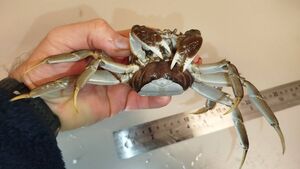'High impact invasive alien species' found in Waterford

"This is a high impact invasive alien species": A Chinese mitten crab was found in the Cheekpoint area of Waterford. Photo: UCD InEco
The University College Dublin Invasive Ecology laboratory is raising the alarm about a "high-impact invasive alien species" which has been spotted in the Cheekpoint area in Waterford. A small female Chinese Mitten Crab was spotted in the Déise waters and the National Biodiversity Data Centre was alerted of the potentially disruptive non-native species and reached out to the UCD team.
The UCD InEco laboratory (Invasive Ecology) is a research group that investigates different invasive species to "understand the potential impact of invasive species on our environment, and to look at solutions as to how we can look to manage them to try and reduce their spread and ecological impact."
"In terms of management we look at what measures can be put in place [...] to mitigate against the potential impacts," said invasive biology expert, Dr Jan-Robert Baars, an assistant professor in the UCD School of Biology and Environmental Science.
Speaking to Waterford News & Star, Dr Jan-Robert Baars explained that the Chinese mitten crab is "quite a complex species" that can live in both salt and fresh water, spending most of its life in fresh waters before travelling to sea to reproduce and mature its eggs. With the potential of the crab species spending much of its time in Waterford's estuaries, it presents a risk of destabilizing the natural balance of the area's "highly complex" estuaries.
Dr Baars said that users of the waterways in Waterford encounter the species during its reproductive season while it travels into the saltwater areas: "That's quite a vast area in case of the Waterford area" in which the crabs are laying and maturing eggs.
The Invasive Ecology team say that due to the relatively small population of the mitten crab, they are unsure exactly what areas the crabs are migrating from and are mostly finding them in the saltwater conditions in Cheekpoint. The team are calling for anyone who spots the crabs to inform the National Biodiversity Data Centre so they can build up their knowledge of the species' movements.
"What they do internationally, is when the crab moves from freshwater to seawater they usually go past some point where you can actually intercept them - that could be a weir or something similar - but unfortunately, we don't really have that. At the moment, we don't find the population of mitten crabs above places like Saint Mullins and so we're not quite sure where we could intercept them."
The ecological expert explained that the mitten crab is a "high-risk" species as it "has the potential to have a high impact in Ireland." The population of the invasive species is still small in Ireland so far, so the realised impact is relatively low, but Dr Baars explains that the species' ability to travel "more than 1,000 kilometres upstream" in freshwater rivers has had a serious impact in different parts of Europe.
"It does this huge migration to go and reproduce into the marine environment," Dr Baars explained that this ability means that it could migrate into and have an impact in most parts of Ireland "if it gets established".
"Now, the impact really comes from it predating on lots of our native species. It feeds on all kinds of invertebrates, as well as the eggs of fish."
The expert noted that the species poses a risk to the structure of Ireland's freshwater systems: "One of the biggest impacts is also the burrows that it creates" - these burrows, which can reach high levels of density of 30 burrows per square metre, "can compromise the structure of canals and river banks and release sediments into the water," Dr Baars said.






